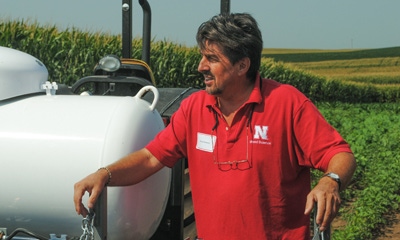
Producers all know the value of a fall burndown herbicide treatment in fighting tough weeds into the next growing season. University of Nebraska Extension integrated weed management specialist Stevan Knezevic says that a key component in fighting herbicide-resistant marestail is fall or spring burndown treatments. In many cases, producers say that they can tell where they sprayed in the fall down to the row during the following growing season.

BURN DOWN WEEDS: UNL Extension integrated weed management specialist Stevan Knezevic says that fall is the perfect time to easily kill rosettes of tough winter annuals before they become a problem.
Winter annuals start growing in the fall, including some tough weeds like marestail, Knezevic says. “Seeds of winter annuals like tansy mustard, field pennycress, henbit, shepherdspurse and marestail can germinate as early as September, and start growing under the corn or soybean canopy,” Knezevic says. “Their rosettes can green up easily under the crop canopy because there is enough light penetrating the crop as the crop leaves start senescing in September and October. Therefore, rosettes can be seen during soybean and corn harvest.”
Fortunately, the rosettes are easy to control with fall-applied herbicides, especially for marestail. “The key is to apply at least four to five days before cold weather hits,” Knezevic says. “Most post-herbicides require a minimum of 50 degrees F at night and 60 degrees in the daytime for four or five days in order to translocate well within the plant,” he explains. “Several herbicide options are available for fall burndown in both corn and soybeans.”
An example would be 2,4-D plus dicamba, which Knezevic says can provide 80% to 90% control of rosettes with no crop rotation restrictions. For other herbicide options, he suggests checking the tables of “Weed Response to Fall Burndown Herbicides” in the corn and soybeans sections of the 2016 UNL Guide for Weed, Disease and Insect Management in Nebraska.
About the Author(s)
You May Also Like






